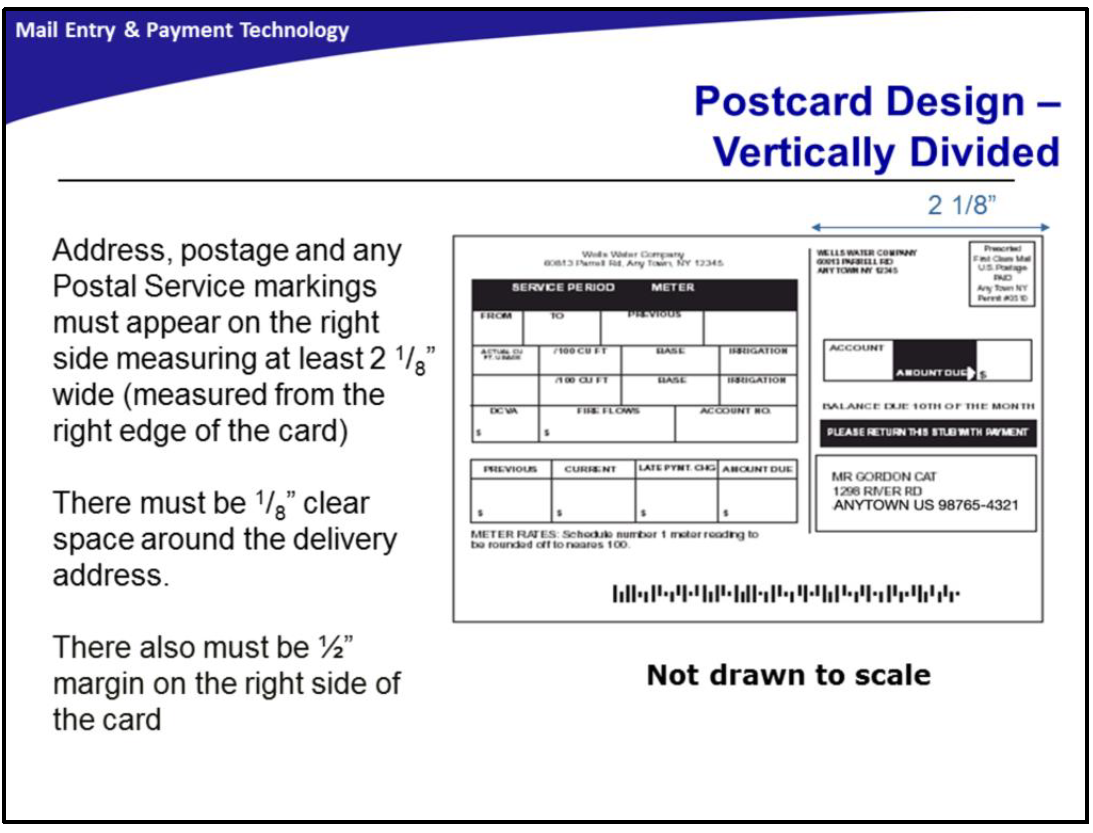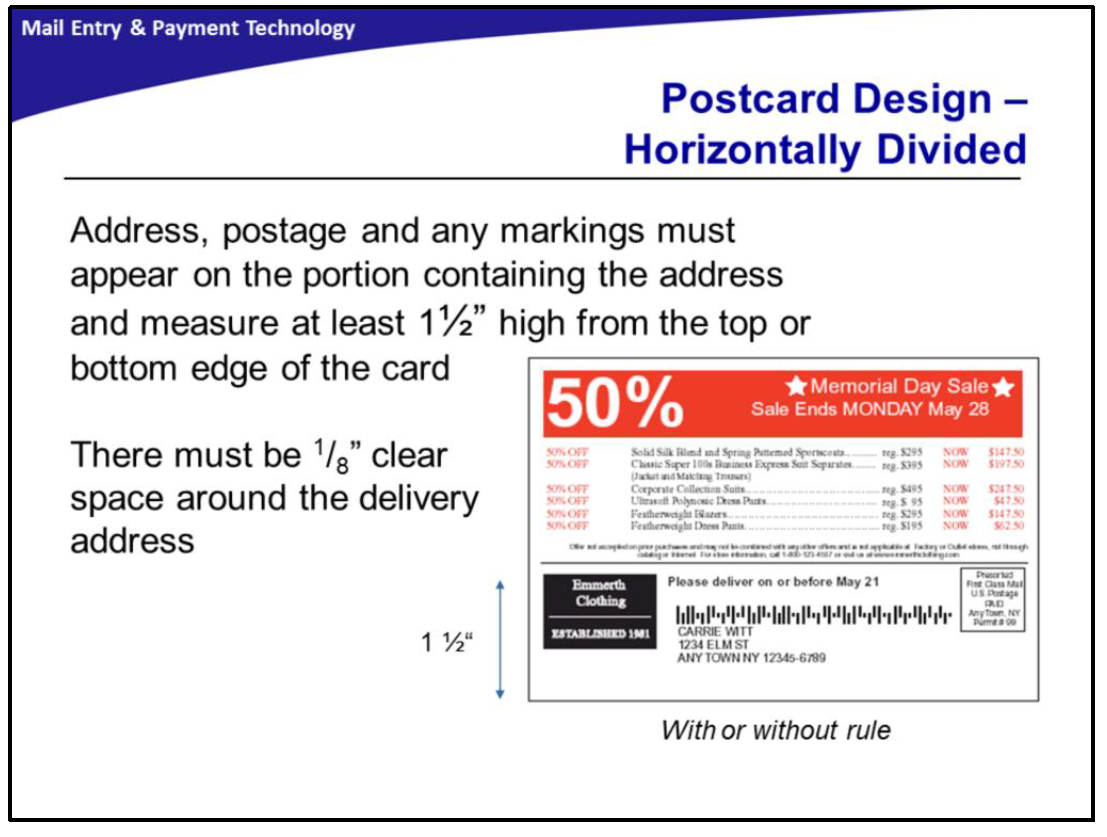The Most Common Mistakes in Mail Piece Design: Part Two |
| By Amanda Armendariz |
|
|
|
Your mail piece is one of the best ways to communicate with customers, but if you make an error in the design process, you can lose your chance to engage with your consumer and drive their behavior. We covered the first five most common mistakes last month, and now it's time to look at the remainder. If any of these sound familiar, it’s time to re-think your design process. Your customers (and your bottom line) will thank you. Postcard Design Ah, postcards. A popular (with good reason) choice for mailers to grab their customers' attention. But if a mistake is made in the design, it can derail your whole marketing effort. In addition to meeting the applicable dimensional requirements, the address side panel of presorted or First-Class postcards and cards must be properly formatted if it contains a message area. The dimensional requirements are:
The cards can be formatted either vertically or horizontally. Vertical Format The address side of vertically divided cards must be divided into a right portion and a left portion, with or without a vertical rule. The left portion is the message area. The delivery address, postage, and any USPS marking or endorsement must appear in the right portion. The right portion must be at least 2 1/8 inches wide (measured from the right edge of the card, top to bottom inclusive). If pre-barcoding in the address block, the right side will have to be approximately four inches to accommodate the largest barcode and the half-inch required margin. For cards claimed at the presorted price, nondelivery address information may extend into the right portion only above the address block and if the information is shaded or surrounded by a border that has at least 1/8-inch clearance between the delivery address block and the border. Mailers may choose not to shade or border the nondelivery address information if there is at least 1/8-inch of clear space around the delivery address block. 
Horizontal Format The address side of a horizontally divided card must be divided into an upper portion and a lower portion, with or without a horizontal rule. The portion of the address side that does not contain the delivery address is the message area. The delivery address, postage, and any USPS marking or endorsement must appear within the portion containing the delivery address. As an alternative, when the delivery address appears within the lower portion, it is permissible for the postage, return address, and any USPS marking or endorsement to appear in the upper portion. The portion bearing the delivery address must be at least one and a half inches high (measured from the bottom edge of the card but above 5/8 inches from bottom, as applicable, right edge to left edge inclusive). Only mail pieces that are pre-barcoded should have a return address in the bottom addressing area. Also, cards that are horizontally divided can only have an indicia or pre-cancelled stamps in the bottom addressing area. If you are using live postage stamps, they must be in the upper right corner of the card. For cards claimed at the presorted price, nondelivery address information may extend into the portion containing the delivery address only if it appears above the address block and if the information is shaded or surrounded by a border that has at least 1/8-inch clearance between the delivery address block and the border. Mailers may choose not to shade or border the nondelivery address information if there is at least 1/8 inch of clear space around the delivery address block. 
Insert Shift Another common concern is window envelopes and insert shift. During postal processing utilizing automated equipment, some of the delivery address and/or mailer-applied barcode excessively shifts, becoming obstructed by one or more of the window edges. When this occurs, automated equipment is unable to successfully process the mail. The address window must be located so the barcode is visible through the window and will meet the positioning requirements for address block barcoding. The barcode in an address block barcode may appear:
When the mailer-applied barcode is included as part of the address block showing through a window, the following minimum barcode clearances must be maintained during the insert’s range of motion in the envelope:
The printing of the barcode is prohibited anywhere between the address line containing the recipient’s name and the city, state, and ZIP Code line. The Postal Service prefers window coverings, but it does not require them except for heavy letter mail. Window coverings, if used, must be sufficiently transparent to allow the barcode and its background to meet the reflectance requirements for barcodes. The Postal Service makes this determination by measuring the barcode’s reflectance through the window material using a USPS Envelope Reflectance Meter. The window must be at least 1/2 inch from the right edge of the mail piece, and the leftmost bar of the barcode must be less than 10.5 inches from the right edge of the mail piece, and at least 1/2 inch from the left edge of the mail piece. Folded Self-Mailer Construction First of all, what is a folded self-mailer? It's a letter-sized mail piece that is formed by two or more panels that are created when one or more unbound sheets of paper are folded together and sealed. If the design of this mail piece does not comply with the USPS applicable machinable and automation compatibility construction and sealing standards, the result significantly increases the customer’s mailing costs. Gatefold designs, for example, are not considered machineable and therefore are not eligible for automation pricing. If you are mailing out a folded self-mailer, keep in mind the following requirements:
The only acceptable folding methods and the subsequent number of panels created when folding a single sheet of paper are:
In addition to gatefolds, accordion and Z-folds are not automation compatible and are considered non-machinable. Address Placement for Enveloped, Polywrapped, or Card-style Flats The following standards apply to enveloped, polywrapped, or card-style periodicals, including shrinkwrapped firm bundles, standard mail, bound printed matter, media mail, and library mail flats mailed at presorted, automation, or carrier route prices. The “top” of the mail piece is either of the shorter edges. The entire delivery address must be within the top half of the mail piece. The optimal placement is at the top edge (while maintaining the 1/8-inch clearance requirement). If a vertical address will not fit entirely within the top half, the address may cross the midpoint if it is placed within one inch of the top edge. If the delivery address is placed on an insert polywrapped with the host piece, the address must not appear on a component that rotates within the bag and must remain visible throughout the addressed component's range of motion. The insert must be affixed to maintain the address entirely in the top half throughout processing and delivery or, if not affixed, the insert must maintain at least the beginning 0.5 inch of the address in the top half. Procedure for Requesting a Uniquely Assigned BRM ZIP+4 Code All business reply mail (BRM) must contain a uniquely assigned ZIP+4 Code to separate the BRM from the customers' regular mail. This is so the USPS can obtain payment for these mail pieces. To obtain a uniquely assigned BRM ZIP+4, the customer must do the following: 1.Open a BRM permit or bring in a receipt from an existing BRM permit from another Post Office to the Post Office where the BRM will be returned, along with a letter of authorization from the permit holder showing the name, address, and telephone number of the local agent authorized to receive the BRM to the Post Office where the BRM is to be returned. 2.Complete Section 1 of the PS Form 6805 and bring it to that Post Office. In some larger Post Offices, the customer will need to bring it into the Mailing Requirements office. 3.The clerk will complete Section 2 of the form, verifying the permit is current, sign Section 2 and fax it to the District Address Management Office. 4.The District AMS office will issue a unique BRM ZIP+4 Code for the customer, sign Section 3 and return it to the clerk that signed Section 2. 5.The clerk will notify the customer that submitted the form and provide them a copy of the completed form, the instructions for the automated business reply mail (ABRM) tool, the phone number (855.593.6093), and the email address (mda@usps.gov) of MDA help desk if they need help with the ABRM tool and retain a copy of the PS Form 6805. 6.Once the customer receives the form, they can create their artwork on the ABRM tool. Conclusion Well, there you have it, folks. The top 10 most common mistakes in mail piece design. It's likely that at least one of these sounds familiar to you, but now you have the tools necessary to fix the issue. You can also always contact the MDA help desk if you need additional assistance. Once again, I'd like to extend a huge thank-you to Rob Hanks, Mailing Support Specialist at Suttle-Straus, and the Madison, Wisconsin-area Postal Customer Council (PCC) for allowing me to use material from their presentation in this article. It’s also a great reminder that PCC meetings like this are excellent resources for mailers looking for the most comprehensive industry knowledge. We’ve written on this in the past, but it can’t be said enough — if you wish to excel in the industry, organizations like this are a great place to start. Amanda Armendariz is Editor, Mailing Systems Technology media, with over a decade of experience covering the postal industry. She can be contacted at amanda.c@rbpub.com. |
